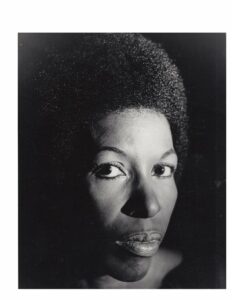
Mari Evans, poet and activist
Born in Toledo, Ohio, Mari Evans arrived in Indianapolis in 1947. She was a John Hay Whitney Fellow in 1965-1966, established by the John Hay Whitney Foundation in 1946 to provide educational support to minorities and the economically underprivileged.
A member of the Black Arts Movement (a 1960s-1970s movement that created new cultural institutions and conveyed a message of Black pride), she produced and narrated The Black Experience, a television program “by and about black people,” which appeared from 1968 to 1973 on WTTV Channel 4. It was during this time that she published her first book, Where is All the Music (1969).
Evans joined the faculty of Indiana University-Purdue University Indianapolis (IUPUI) in 1969 teaching the course, “Recent Black American Writing.” The following year, her book, I am a Black Woman (1970), asserted the role of Black women in creating African American culture and instilling resiliency in the community. Her play or choreopoem (a form of dramatic expression that combines poetry, dance, music, and song), River of My Song, premiered at The Children’s Museum in May 1977. Evans viewed her 1979 adaptation of Eyes, a musical of Their Eyes Were Watching God, written by Zora Neale Hurston (an author, anthropologist , and filmmaker who portrayed racial struggles in the South during the early-1900s), as an extension of her love and passion for music. Her later writings include A Dark and Splendid Mass (1992), Clarity as Concept (2004), and Continuum (2007). She also wrote children’s books.
In 1983, Evans was the editor of the anthology Black Women Writers: Arguments and Interviews. Her goal for the project was ”lofty and complex.” The project brought together 39 African American writers and critics ”for the single, serious purpose of discussing the creative works of contemporary African-American women,” and to that she proclaimed, “It has been infinitely rewarding.”
In the March/April 2007 issue of the Crisis, the official magazine of the NAACP, Evans noted that, “The only insurmountable obstacle I’ve faced is being a Black writer.” She stated that being African American made her struggles for recognition as an artist much more difficult than did being a woman. It gave her no way to “cross into a realm that would pay more.” Nevertheless, Evans proclaimed that she was most concerned with truth and integrity in her writing.
Evans also was an activist for the Black community. She protested at the steps of the Indiana War Memorial in June 1975 in response to the death of Byron L. Richardson following a high-speed chase. In 1976, she was involved with and served as a chairperson for the Black Educational Coalition. She was against the death penalty and fought for prison reform. She once noted that she was a “philosopher, poet, writer. I am all that I am a political writer.”
Her legacy lives in her work and in the recognition of her status as a major Black writer. Created in 1996, The Zora Neale Hurston-Mari Evans Scholarship helps to educate students at IUPUI. Uganda issued a postage stamp of Evans in 1997. She received recognition as a Living Legend by the Indiana Historical Society in 2004, and the Indiana Authors Award (Glick Indiana Authors Award) and the 2015 Indiana Authors Award Lifetime Achievement Award. There is a large mural of Evans on 448 Massachusetts Avenue created by Michael Jordan, a.k.a. ALKEMI, in 2016.
Kisha Tandy

